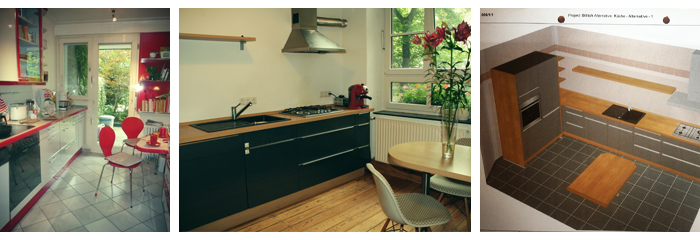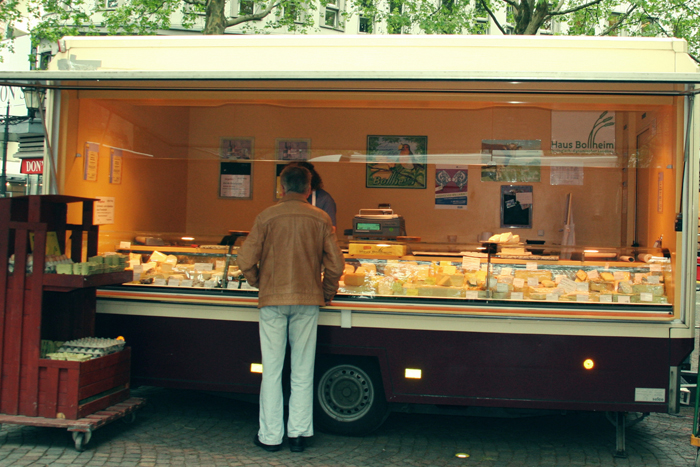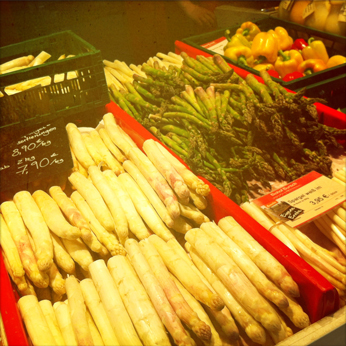それは約3年前の出来事。ドイツ・ケルンで賃貸アパートメントを探し始めたとき、衝撃的な事実に気づいた。「家にキッチンがない……!?」 作りつけのクローゼットが存在しないことは見知りしていたものの、まさかキッチンまでとは。そう、信じ難いことにドイツでは、賃貸物件であってもキッチンが設置されていないのが通例。システムキッチンを新しくオーダーするか、自分が以前使っていたキッチンを持ち込む、あるいは前の住人が使っていたものを買い取るという選択肢があるのみだ。われわれ夫婦の場合は東京から引っ越して来たし、前の住人はキッチンと一緒に出て行ったので買うよりほかはなく、入居前に寸法を測りキッチンセンターに通う週末が続いた。3Dで見せてくれる完成イメージに夢を膨らませ、注文してから待つこと2ヶ月の一大プロジェクト。まさか2ヶ月間もキッチンなしで暮らすことになるなんて。まったく想像していなかったリアルなドイツ生活の幕開けだった。
節約家で有名なドイツ人がシステムキッチンにはお金をかけ(言うまでもなく自動車にもだが)、親しい間柄や家族の間ではキッチン内の簡易テーブルで食事を取ったりお茶を飲んだり、あるいは読書したりと、料理をせずともキッチンで心地よい時間を過ごす。まるでキッチンに暮らしているように。待ち焦がれて生まれて初めて自分のキッチンを所有してみると、ふつふつと愛着が湧き、キッチンに並々ならぬ愛情を抱くドイツ人の気持ちに自分もほんの少し近づけたように思えた。そして、住まう人間の数だけキッチンの表情があるにことに気づく。ライフスタイルの要であるキッチンには、その空間に暮らす人々のパーソナリティが如実に現れているのだ。

たとえば、上の左写真は夫の実家のキッチン。赤×白のハッピーなコントラストは、義母の快活なキャラクターと重なって映る。中央写真は完成後の我が家のキッチン、右写真が3D設計図。ミニマルさにオーク材であたたかみを加えたテイストが、案外私たちにしっくりきた。
Bulthaup(ブルトハウプ)、Poggenpohl(ポーゲンポール)、SieMatic(ジーマティック)など世界的名門キッチンメーカーがあふれるキッチン大国ドイツ。ドイツのキッチン業界の市場規模は約40億ユーロ(約5280億円)で、ヨーロッパにおける売上高でトップ10にランクする会社のうち6社はドイツ企業が占める。キッチンに投資するのなら当然食材にも?とイメージしがちだが、国連のデータによればドイツ人が食品にかけるお金は支出に対してわずか10%に過ぎない(参考までにフランスは13.4%、イタリアとスペインは15%、アメリカは6.9%)。とはいえ、この数字は単に食に対する関心の低さを表すのではない。Aldi、Lidlといったディスカウントスーパー台頭の影響で、食料品の価格がその他ヨーロッパ諸国に比べて15~20%も安いのが要因だ。ディスカウントスーパーの勢力が増す一方で、同時にBIO製品(オーガニック食品)のブームが継続しているのも見逃せない。ケルンでもビオマルクト(BIO製品のみを扱うスーパー)は増え続け、各地で週に数回開催されるエコマルクト(BIO製品の青空市)はいつも人々でにぎわっている。食品の安全性に対する意識の高さゆえ、ベーシックなものはディスカウントスーパーで買い、生鮮食品はBIO製品を選ぶという、倹約意識とオーガニック意識の両方を持ち合わせた消費者が多いといえそう。



野菜やパン、チーズ、鳥肉専門店などが立ち並ぶ自宅近くのエコマルクトへ足を運ぶと、今が旬のシュパーゲル(ホワイトアスパラガス)が野菜スタンドの主役だった。1kgのシュパーゲルを買って帰り、その夜は某有名シェフ直伝の自家製オランデーズソース*1とともに、春の味覚に舌鼓。その日もまた、リビングルームにあるダイニングテーブルは使わず、こぢんまりとして居心地のいいキッチンで食卓を囲む。ドイツで学んだキッチン暮らし。キッチン空間への愛情は日ごとに少しずつ、尽きることなく増すようだ。
It happened about 3 years ago. When I started searching for apartments for rent in Cologne, Germany, I realized a shocking truth. No kitchens in homes...!? Although I was familiar with the fact that built-in closets don't exist, I had never imagined that even kitchens don't exist. That's right—as hard as it is to believe, in Germany, it is common for even rental apartments to not have kitchens. Your only options are to order a new unit kitchen, to bring the kitchen you were previously using, or to buy the one used by the previous owner. In our case, we had moved from Tokyo, and the previous owners had taken the kitchen with themselves, so we had no choice but to buy our kitchen. We measured the space before moving in and spent weekends going to kitchen stores. It was a big project, filling our dreams with its complete 3D images, that we had to wait 2 months for after ordering. I had never thought I would live 2 months without a kitchen! It was a completely unimaginable start to my real life in Germany.
Famous for their penny-pinching, Germans spend their money on unit kitchens (and, of course, their cars), so the family and their closest relations spend relaxing time in the kitchen without cooking, eating or drinking tea, or reading at the portable kitchen table. It's just as if they're living in their kitchens. Once I had my first long-awaited-for kitchen, I started to grow attached to it, and felt that I had gotten closer to the feeling of Germans who have an exceeding affection for their kitchens. Then I realized that there are as many styles of kitchens as there are residents. In the kitchens, so central to one's lifestyle, the personalities of the residents are realistically reflected in the space.
For example, the left picture above is my husband's family's kitchen. The happy, red and white contrast overlaps with my mother-in-law's cheerful character. The middle picture is our kitchen after its completion, and the picture to the right is the 3D image of our kitchen. The minimalistic taste and added warmth with oak fit unexpectedly well with us.
The great nation of Germany is filled with world famous kitchen manufacturers such as SieMatic, Poggenpohl, and Bulthaup. The size of the German kitchen market is 40 billion euro (about 5,280 billion yen), with 6 German companies ranking in among the top 10 sales in companies in Europe. We imagine that if we invest in kitchens, we should also invest in ingredients, but according to UN data, the money Germans spend on groceries is no more than a mere 10% of their expenditures (for comparison, France is 13.4%, Italy and Spain are 15%, and the US is 6.9%). Even so, these numbers don't just show a lack of interest in meals. Under the influence of the rise of discount supermarkets like Aldi or Lidl, one cause is that the price of groceries is 15-20% cheaper compared to all other European countries. We also can't overlook the fact that while the influence of discount supermarkets increases the BIO products (organic foodstuffs) boom is continuing. Even in Cologne, BioMarkt (a supermarket carrying only BIO products) are continuing to increase and everywhere Eco Markt (BIO product open-air markets) held multiple times a week are always busy with people. As a consequence of increasing consciousness toward safety of groceries, we could say that there are many consumers with both an organic consciousness and a frugal consciousness, where they buy basic necessities at the discount supermarkets and choose BIO products for raw and fresh foods.
When I went down to the local Eco Markt lined with vegetables and breads, cheese and chicken stalls, Spargel (white asparagus), currently in season, was the star. I bought 1 kg of Spargel to take home and that night we licked our lips to this taste of spring with homemade hollandaise sauce directly from a certain famous chef. That day we did not use the dining table in the living room. We sat around the cozy table in the kitchen. I've learned to live in my kitchen in Germany. I think my affection for the kitchen space will increase a little bit every day.
 たとえば、上の左写真は夫の実家のキッチン。赤×白のハッピーなコントラストは、義母の快活なキャラクターと重なって映る。中央写真は完成後の我が家のキッチン、右写真が3D設計図。ミニマルさにオーク材であたたかみを加えたテイストが、案外私たちにしっくりきた。
Bulthaup(ブルトハウプ)、Poggenpohl(ポーゲンポール)、SieMatic(ジーマティック)など世界的名門キッチンメーカーがあふれるキッチン大国ドイツ。ドイツのキッチン業界の市場規模は約40億ユーロ(約5280億円)で、ヨーロッパにおける売上高でトップ10にランクする会社のうち6社はドイツ企業が占める。キッチンに投資するのなら当然食材にも?とイメージしがちだが、国連のデータによればドイツ人が食品にかけるお金は支出に対してわずか10%に過ぎない(参考までにフランスは13.4%、イタリアとスペインは15%、アメリカは6.9%)。とはいえ、この数字は単に食に対する関心の低さを表すのではない。Aldi、Lidlといったディスカウントスーパー台頭の影響で、食料品の価格がその他ヨーロッパ諸国に比べて15~20%も安いのが要因だ。ディスカウントスーパーの勢力が増す一方で、同時にBIO製品(オーガニック食品)のブームが継続しているのも見逃せない。ケルンでもビオマルクト(BIO製品のみを扱うスーパー)は増え続け、各地で週に数回開催されるエコマルクト(BIO製品の青空市)はいつも人々でにぎわっている。食品の安全性に対する意識の高さゆえ、ベーシックなものはディスカウントスーパーで買い、生鮮食品はBIO製品を選ぶという、倹約意識とオーガニック意識の両方を持ち合わせた消費者が多いといえそう。
たとえば、上の左写真は夫の実家のキッチン。赤×白のハッピーなコントラストは、義母の快活なキャラクターと重なって映る。中央写真は完成後の我が家のキッチン、右写真が3D設計図。ミニマルさにオーク材であたたかみを加えたテイストが、案外私たちにしっくりきた。
Bulthaup(ブルトハウプ)、Poggenpohl(ポーゲンポール)、SieMatic(ジーマティック)など世界的名門キッチンメーカーがあふれるキッチン大国ドイツ。ドイツのキッチン業界の市場規模は約40億ユーロ(約5280億円)で、ヨーロッパにおける売上高でトップ10にランクする会社のうち6社はドイツ企業が占める。キッチンに投資するのなら当然食材にも?とイメージしがちだが、国連のデータによればドイツ人が食品にかけるお金は支出に対してわずか10%に過ぎない(参考までにフランスは13.4%、イタリアとスペインは15%、アメリカは6.9%)。とはいえ、この数字は単に食に対する関心の低さを表すのではない。Aldi、Lidlといったディスカウントスーパー台頭の影響で、食料品の価格がその他ヨーロッパ諸国に比べて15~20%も安いのが要因だ。ディスカウントスーパーの勢力が増す一方で、同時にBIO製品(オーガニック食品)のブームが継続しているのも見逃せない。ケルンでもビオマルクト(BIO製品のみを扱うスーパー)は増え続け、各地で週に数回開催されるエコマルクト(BIO製品の青空市)はいつも人々でにぎわっている。食品の安全性に対する意識の高さゆえ、ベーシックなものはディスカウントスーパーで買い、生鮮食品はBIO製品を選ぶという、倹約意識とオーガニック意識の両方を持ち合わせた消費者が多いといえそう。


 野菜やパン、チーズ、鳥肉専門店などが立ち並ぶ自宅近くのエコマルクトへ足を運ぶと、今が旬のシュパーゲル(ホワイトアスパラガス)が野菜スタンドの主役だった。1kgのシュパーゲルを買って帰り、その夜は某有名シェフ直伝の自家製オランデーズソース*1とともに、春の味覚に舌鼓。その日もまた、リビングルームにあるダイニングテーブルは使わず、こぢんまりとして居心地のいいキッチンで食卓を囲む。ドイツで学んだキッチン暮らし。キッチン空間への愛情は日ごとに少しずつ、尽きることなく増すようだ。
野菜やパン、チーズ、鳥肉専門店などが立ち並ぶ自宅近くのエコマルクトへ足を運ぶと、今が旬のシュパーゲル(ホワイトアスパラガス)が野菜スタンドの主役だった。1kgのシュパーゲルを買って帰り、その夜は某有名シェフ直伝の自家製オランデーズソース*1とともに、春の味覚に舌鼓。その日もまた、リビングルームにあるダイニングテーブルは使わず、こぢんまりとして居心地のいいキッチンで食卓を囲む。ドイツで学んだキッチン暮らし。キッチン空間への愛情は日ごとに少しずつ、尽きることなく増すようだ。









